With the holiday shopping season in full swing, most retail advertisers are focused on how they can get their products in front of the most potential buyers and maximize sales. If trends from last year’s holiday shopping season are any indication of this year’s, most consumers will look online to research and purchase products.
According to a US Retail eCommerce study by eMarketer, 90% of consumers browsed, researched, or compared products online last year, and an impressive 83% of US digital shoppers made a purchase online.[1] As consumers continue to shift towards digital media as their holiday shopping channel of choice, the opportunity for retail advertisers to reach more potential customers during this critical time period will continue to grow.
With these retail advertising trends and opportunities in mind and to help retailers showcase their products to more customers, we’ve released support for Bing Shopping Campaigns. Marin Search advertisers can now drive sales on Bing using an engaging and impactful ad format that contains images, pricing, and physical store information. They can holistically manage, measure, and optimize their Bing Shopping campaigns and product groups alongside Google, allowing them to budget more intelligently across publishers and drive better overall shopping campaign performance.
There are several great reasons retail advertisers should get started with Bing Shopping Campaigns now. In this post, we highlight expanding reach and enhancing the user experience.
Bing Shopping Campaigns can help you expand your reach and engage more potential buyers
Leading search engines, like Bing, have long been a top channel that consumers use not only to purchase products online, but also to influence purchasing decisions from “showrooming” in a retailer’s physical store. In fact, according to a Search Engine Land study, 73% of consumers use search engines to find where products are sold, 72% use them to make price comparisons, and 63% use them to find promotional offers.
Product ads, managed through Bing Shopping campaigns, can help retail advertisers surface the top information consumers are looking for while they’re showrooming, putting the shopper closer to an online purchase. With more than 540 million retail researches occurring in Bing every month, the potential reach and exposure that Bing Shopping Campaigns offers to retail advertisers is massive.
Bing Shopping Campaigns can help get your brand get in front of more potential customers, and supplement the traffic that you’re probably already getting from Google Shopping Campaigns.
Bing Shopping Campaigns offers advertisers an improved experience over legacy Bing Product Ads
Many retailers are already advertising with Bing Product ads, and will need to convert their legacy campaigns to the recently released version of Bing Shopping Campaigns. Others may have held off testing Product Ads in the past because of limited features.
Either way, Bing Shopping Campaigns offers significant workflow and reporting enhancements over the legacy Product Ads offering. These improvements create a compelling case to try the new offering now.
Some of the incremental benefits of Bing Shopping Campaigns enhancements relative to Product Ads campaigns include:
- Better control over your product ads when targeting for certain products. Now, with Bing Shopping Campaigns, retail advertisers can target the products in their feeds with a high degree of granularity within the UI. Bing’s new product hierarchy view for Shopping Campaigns gives you more control over what products you’re showing and how much you’re paying. It’s a simple way to organize, manage, bid, and report on ads. In addition, advertisers can now easily prioritize which campaign to run when running multiple advertising campaigns for the same product.

- A more streamlined workflow and easier campaign management. Bing Shopping Campaigns offers advertisers new, intuitive ways to view all the published offers from their data feeds in a hierarchical tree within the Bing Ads UI. In addition, they’ve made it much easier to view your inventory by assigning attributes like brand or product type, selecting inventory you want to promote (or exclude), and setting appropriate bids.

- Enhanced product insights and advanced reporting. Bing Shopping Campaigns now offer Share of Voice reporting and provide insight into impressions, clicks, average click-through rate, and average cost-per-click, relative to your product targets. This is a significant improvement from legacy Product Ads reporting. In addition, Bing Shopping Campaigns reporting now offers deep insight into your campaign performance and allows you to see performance data at an item ID level right within the Bing Ads UI.

In our next post, we discuss optimizing and scaling your Bing Shopping Campaigns program, and the streamlined setup process. To keep up with all the latest posts, be sure to subscribe to our blog.
[1] Source: US Retail Ecommerce: 2014 Trends and Forecast, eMarketer, April 2014
Digital & Social Articles on Business 2 Community(77)
Report Post



